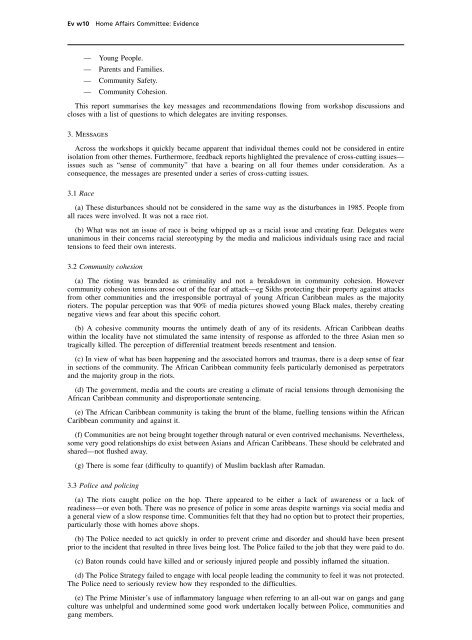Policing Large Scale Disorder: Lessons from the disturbances of ...
Policing Large Scale Disorder: Lessons from the disturbances of ...
Policing Large Scale Disorder: Lessons from the disturbances of ...
You also want an ePaper? Increase the reach of your titles
YUMPU automatically turns print PDFs into web optimized ePapers that Google loves.
Ev w10 Home Affairs Committee: Evidence<br />
— Young People.<br />
— Parents and Families.<br />
— Community Safety.<br />
— Community Cohesion.<br />
This report summarises <strong>the</strong> key messages and recommendations flowing <strong>from</strong> workshop discussions and<br />
closes with a list <strong>of</strong> questions to which delegates are inviting responses.<br />
3. Messages<br />
Across <strong>the</strong> workshops it quickly became apparent that individual <strong>the</strong>mes could not be considered in entire<br />
isolation <strong>from</strong> o<strong>the</strong>r <strong>the</strong>mes. Fur<strong>the</strong>rmore, feedback reports highlighted <strong>the</strong> prevalence <strong>of</strong> cross-cutting issues—<br />
issues such as “sense <strong>of</strong> community” that have a bearing on all four <strong>the</strong>mes under consideration. As a<br />
consequence, <strong>the</strong> messages are presented under a series <strong>of</strong> cross-cutting issues.<br />
3.1 Race<br />
(a) These <strong>disturbances</strong> should not be considered in <strong>the</strong> same way as <strong>the</strong> <strong>disturbances</strong> in 1985. People <strong>from</strong><br />
all races were involved. It was not a race riot.<br />
(b) What was not an issue <strong>of</strong> race is being whipped up as a racial issue and creating fear. Delegates were<br />
unanimous in <strong>the</strong>ir concerns racial stereotyping by <strong>the</strong> media and malicious individuals using race and racial<br />
tensions to feed <strong>the</strong>ir own interests.<br />
3.2 Community cohesion<br />
(a) The rioting was branded as criminality and not a breakdown in community cohesion. However<br />
community cohesion tensions arose out <strong>of</strong> <strong>the</strong> fear <strong>of</strong> attack—eg Sikhs protecting <strong>the</strong>ir property against attacks<br />
<strong>from</strong> o<strong>the</strong>r communities and <strong>the</strong> irresponsible portrayal <strong>of</strong> young African Caribbean males as <strong>the</strong> majority<br />
rioters. The popular perception was that 90% <strong>of</strong> media pictures showed young Black males, <strong>the</strong>reby creating<br />
negative views and fear about this specific cohort.<br />
(b) A cohesive community mourns <strong>the</strong> untimely death <strong>of</strong> any <strong>of</strong> its residents. African Caribbean deaths<br />
within <strong>the</strong> locality have not stimulated <strong>the</strong> same intensity <strong>of</strong> response as afforded to <strong>the</strong> three Asian men so<br />
tragically killed. The perception <strong>of</strong> differential treatment breeds resentment and tension.<br />
(c) In view <strong>of</strong> what has been happening and <strong>the</strong> associated horrors and traumas, <strong>the</strong>re is a deep sense <strong>of</strong> fear<br />
in sections <strong>of</strong> <strong>the</strong> community. The African Caribbean community feels particularly demonised as perpetrators<br />
and <strong>the</strong> majority group in <strong>the</strong> riots.<br />
(d) The government, media and <strong>the</strong> courts are creating a climate <strong>of</strong> racial tensions through demonising <strong>the</strong><br />
African Caribbean community and disproportionate sentencing.<br />
(e) The African Caribbean community is taking <strong>the</strong> brunt <strong>of</strong> <strong>the</strong> blame, fuelling tensions within <strong>the</strong> African<br />
Caribbean community and against it.<br />
(f) Communities are not being brought toge<strong>the</strong>r through natural or even contrived mechanisms. Never<strong>the</strong>less,<br />
some very good relationships do exist between Asians and African Caribbeans. These should be celebrated and<br />
shared—not flushed away.<br />
(g) There is some fear (difficulty to quantify) <strong>of</strong> Muslim backlash after Ramadan.<br />
3.3 Police and policing<br />
(a) The riots caught police on <strong>the</strong> hop. There appeared to be ei<strong>the</strong>r a lack <strong>of</strong> awareness or a lack <strong>of</strong><br />
readiness—or even both. There was no presence <strong>of</strong> police in some areas despite warnings via social media and<br />
a general view <strong>of</strong> a slow response time. Communities felt that <strong>the</strong>y had no option but to protect <strong>the</strong>ir properties,<br />
particularly those with homes above shops.<br />
(b) The Police needed to act quickly in order to prevent crime and disorder and should have been present<br />
prior to <strong>the</strong> incident that resulted in three lives being lost. The Police failed to <strong>the</strong> job that <strong>the</strong>y were paid to do.<br />
(c) Baton rounds could have killed and or seriously injured people and possibly inflamed <strong>the</strong> situation.<br />
(d) The Police Strategy failed to engage with local people leading <strong>the</strong> community to feel it was not protected.<br />
The Police need to seriously review how <strong>the</strong>y responded to <strong>the</strong> difficulties.<br />
(e) The Prime Minister’s use <strong>of</strong> inflammatory language when referring to an all-out war on gangs and gang<br />
culture was unhelpful and undermined some good work undertaken locally between Police, communities and<br />
gang members.
















